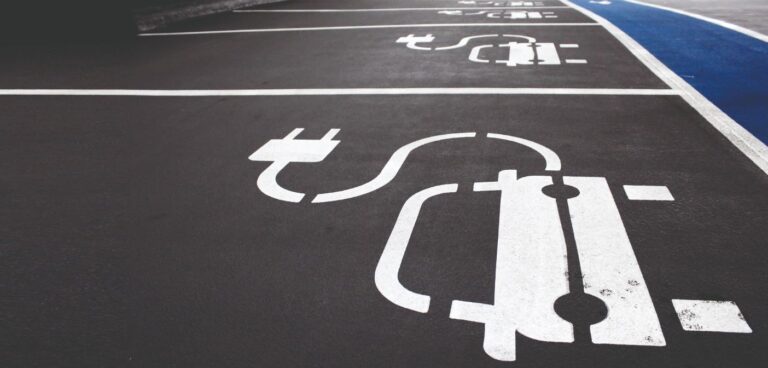Earlier today the UK government announced its new EV charging infrastructure strategy with the goal of installing 300,000 chargepoints by 2030 as well as ensuring that operators must provide real-time data for customers to check the status of chargepoints and apps to locate the nearest one.
The announcement triggered a slew of reactions – both positive and critical – from across the industry, the most notable of which CiTTi Magazine has compiled below:
 Quentin Willson, founder, FairCharge, said: “This strategy is overdue but welcome, because there are real concerns that the rapid growth in EV purchases has been completely outstripping the growth in public chargers. Even the target for 300,000 chargers by 2030, which is the first recognition of the scale of the need by DfT, is a 12x increase in the amount of public chargers from present. But EV usage is due to increase by more than 30x in that period. And the government really needs to get on with delivery sooner rather than later or else we risk a situation in a few years’ time when millions of new EV drivers will be disappointed and disillusioned with the state of the charging infrastructure. One way the government could accelerate growth in the EV charging market – not mentioned in the Strategy – is to slash the ludicrous VAT differential between public (20%) and home charging (5%).”
Quentin Willson, founder, FairCharge, said: “This strategy is overdue but welcome, because there are real concerns that the rapid growth in EV purchases has been completely outstripping the growth in public chargers. Even the target for 300,000 chargers by 2030, which is the first recognition of the scale of the need by DfT, is a 12x increase in the amount of public chargers from present. But EV usage is due to increase by more than 30x in that period. And the government really needs to get on with delivery sooner rather than later or else we risk a situation in a few years’ time when millions of new EV drivers will be disappointed and disillusioned with the state of the charging infrastructure. One way the government could accelerate growth in the EV charging market – not mentioned in the Strategy – is to slash the ludicrous VAT differential between public (20%) and home charging (5%).”
 Cllr David Renard, transport spokesperson, Local Government Association, said: “Councils are determined to tackle climate change and drive down harmful transport related emissions and are already supporting the transition to EVs. This funding is a significant boost to those efforts which will help secure staffing and resources to better plan and invest in local charge point networks, in partnership with commercial operators. It will also help ensure that there is access where it is needed, in particular for those without access to off-street parking. Councils are best-placed to ensure chargepoints are delivered in the right places and avoiding inappropriate or poor location. All councils need to benefit and have full flexibility to maximise the impact of the funding. While funding is one barrier to progress, we await details as to how the government intends to deal with other obstacles such as high costs of connection points to the electric grid, and access to expertise.”
Cllr David Renard, transport spokesperson, Local Government Association, said: “Councils are determined to tackle climate change and drive down harmful transport related emissions and are already supporting the transition to EVs. This funding is a significant boost to those efforts which will help secure staffing and resources to better plan and invest in local charge point networks, in partnership with commercial operators. It will also help ensure that there is access where it is needed, in particular for those without access to off-street parking. Councils are best-placed to ensure chargepoints are delivered in the right places and avoiding inappropriate or poor location. All councils need to benefit and have full flexibility to maximise the impact of the funding. While funding is one barrier to progress, we await details as to how the government intends to deal with other obstacles such as high costs of connection points to the electric grid, and access to expertise.”
 Mike Hawes, chief executive, Society of Motor Manufacturers and Traders, said: “The EV infrastructure strategy points in the right direction, addressing problems with the current customer charging experience and setting out a nationally co-ordinated, locally delivered plan that aims to ‘build ahead of need’. The UK already has an enviable and ever-growing rapid charging network, so focus must be given to expanding public on-street and destination charging provision. Every stakeholder will have to play their part in this transition but, if industry and consumers are to have the certainty they need to invest, commensurate and binding targets must be set for infrastructure provision. Deployed nationally and at pace, this expansion would give drivers confidence they will be able to charge as easily as they would refuel, wherever they are.”
Mike Hawes, chief executive, Society of Motor Manufacturers and Traders, said: “The EV infrastructure strategy points in the right direction, addressing problems with the current customer charging experience and setting out a nationally co-ordinated, locally delivered plan that aims to ‘build ahead of need’. The UK already has an enviable and ever-growing rapid charging network, so focus must be given to expanding public on-street and destination charging provision. Every stakeholder will have to play their part in this transition but, if industry and consumers are to have the certainty they need to invest, commensurate and binding targets must be set for infrastructure provision. Deployed nationally and at pace, this expansion would give drivers confidence they will be able to charge as easily as they would refuel, wherever they are.”
 Denise Beedell, public policy manager, Logistics UK, said: “For some time now, Logistics UK’s members have called for more equitable ways of funding the necessary expansion of the UK’s electricity capacity to support the decarbonisation of the UK’s commercial vehicle fleets. We are very pleased to see the strategy address this significant barrier to improve the infrastructure required for the electrification of commercial vehicle fleets as logistics businesses work to reach net zero as soon as possible. We look forward to seeing the details of how the electricity network will be transformed to ensure cost effective and timely connections this spring, and the Ofgem-Government EV Smart Charging Action Plan this summer.”
Denise Beedell, public policy manager, Logistics UK, said: “For some time now, Logistics UK’s members have called for more equitable ways of funding the necessary expansion of the UK’s electricity capacity to support the decarbonisation of the UK’s commercial vehicle fleets. We are very pleased to see the strategy address this significant barrier to improve the infrastructure required for the electrification of commercial vehicle fleets as logistics businesses work to reach net zero as soon as possible. We look forward to seeing the details of how the electricity network will be transformed to ensure cost effective and timely connections this spring, and the Ofgem-Government EV Smart Charging Action Plan this summer.”
A ndré Dias, CTO and founder, GoWithFlow, said: “Clearly, the strategy reinforces the urgent requirements for infrastructure improvements to make mass electric mobility possible. But for mass adoption to be viable this is about more than just the chargepoints. It also includes the need for real time data to allow for customers to check the status of chargepoints and apps in order to find the nearest available one. With the correct, data-driven approach, the EV transition can be a seamless and valuable choice for any individual or business without compromising on either efficiency or costs.”
ndré Dias, CTO and founder, GoWithFlow, said: “Clearly, the strategy reinforces the urgent requirements for infrastructure improvements to make mass electric mobility possible. But for mass adoption to be viable this is about more than just the chargepoints. It also includes the need for real time data to allow for customers to check the status of chargepoints and apps in order to find the nearest available one. With the correct, data-driven approach, the EV transition can be a seamless and valuable choice for any individual or business without compromising on either efficiency or costs.”
 Filip Klippel, automotive manager, Here Technologies, said: “While commendable, the size of the £1.6bn commitment outlines the scale of the EV infrastructure challenge that is facing the country. While the UK currently leads the way in Europe in terms of charging points, there’s still a way to go to build the infrastructure required for the ban on petrol and diesel cars in 2030. With less than a decade remaining, hundreds will need to be added every day to sufficiently meet this target and deliver the so-called ‘green industrial revolution.’ Today’s announcement from the Department of Transport aims to address these challenges, laying the groundwork for the future of EVs in the country. If the promise of today’s announcement is met, and it is still an ‘if’ at this stage, then the UK should expect a greener future where the country and individuals can hit their sustainability goals.”
Filip Klippel, automotive manager, Here Technologies, said: “While commendable, the size of the £1.6bn commitment outlines the scale of the EV infrastructure challenge that is facing the country. While the UK currently leads the way in Europe in terms of charging points, there’s still a way to go to build the infrastructure required for the ban on petrol and diesel cars in 2030. With less than a decade remaining, hundreds will need to be added every day to sufficiently meet this target and deliver the so-called ‘green industrial revolution.’ Today’s announcement from the Department of Transport aims to address these challenges, laying the groundwork for the future of EVs in the country. If the promise of today’s announcement is met, and it is still an ‘if’ at this stage, then the UK should expect a greener future where the country and individuals can hit their sustainability goals.”

Greg Archer, UK director, Transport & Environment, said: “The new investment in charging is welcome. But setting targets and throwing money at a problem is not a national strategy. The plan passes the buck to private companies and local authorities to deliver the UK’s charging network without addressing many of the underlying barriers that slow progress and could lead to under delivery. There is no requirement for local authorities to roll out charging. No interim targets. No proposals to tackle planning delays or regulations to require car park operators to install chargepoints. If progress in rolling out charging does not accelerate, more policy intervention, not money, will be needed to deliver the world-class network the UK needs to end sales of new conventional cars by 2030.”
 Ian Johnston, CEO, Osprey Charging, said: “Today’s announcement by the government is an important step towards ensuring that we have the right number of charging points in all locations across the UK. This is crucial to give everyone the confidence that when they make the switch to electric, they will be able to charge as easily as they refuel today – whenever and wherever they are. These charging stations simply must be reliable, easy to navigate and importantly, accessible for all. There are already many billions of pounds of private investment committed for the deployment of charging infrastructure across the UK from leading networks like Osprey, and the announcements today will allow this funding to provide the critical infrastructure to the areas that are as yet underserved – notably the motorway service areas and the local authority towns and cities across the nation. We look forward to working with the government to help bring this strategy to life, delivering a high quality, inclusive, open-access and reliable charging network that’s worry free, comfortable and enjoyable to use.”
Ian Johnston, CEO, Osprey Charging, said: “Today’s announcement by the government is an important step towards ensuring that we have the right number of charging points in all locations across the UK. This is crucial to give everyone the confidence that when they make the switch to electric, they will be able to charge as easily as they refuel today – whenever and wherever they are. These charging stations simply must be reliable, easy to navigate and importantly, accessible for all. There are already many billions of pounds of private investment committed for the deployment of charging infrastructure across the UK from leading networks like Osprey, and the announcements today will allow this funding to provide the critical infrastructure to the areas that are as yet underserved – notably the motorway service areas and the local authority towns and cities across the nation. We look forward to working with the government to help bring this strategy to life, delivering a high quality, inclusive, open-access and reliable charging network that’s worry free, comfortable and enjoyable to use.”
 Philip Shadbolt, CEO, EZ-Charge, said: “Today’s announcement of the new Electric Vehicle Infrastructure Strategy delivers the right level of investment and ambition at exactly the right time. This will make a massive difference and will really help the UK become global leaders in electric vehicle adoption. The announcement of the new funding is one thing and is certainly very welcome. But it’s the introduction of the new legislation I’m most pleased about. For too long many chargepoint operators have tried to force customers to use only their networks by making them pay a membership fee or download an app to charge. This is not only really inconvenient for electric car drivers, it’s really off-putting to those thinking about making the switch. Forcing operators to do away with these kinds of outdated practices and make the UK’s charging infrastructure work for everybody will be a big step forward.”
Philip Shadbolt, CEO, EZ-Charge, said: “Today’s announcement of the new Electric Vehicle Infrastructure Strategy delivers the right level of investment and ambition at exactly the right time. This will make a massive difference and will really help the UK become global leaders in electric vehicle adoption. The announcement of the new funding is one thing and is certainly very welcome. But it’s the introduction of the new legislation I’m most pleased about. For too long many chargepoint operators have tried to force customers to use only their networks by making them pay a membership fee or download an app to charge. This is not only really inconvenient for electric car drivers, it’s really off-putting to those thinking about making the switch. Forcing operators to do away with these kinds of outdated practices and make the UK’s charging infrastructure work for everybody will be a big step forward.”

Paul Willcox, managing director, Vauxhall, said: “Vauxhall recently welcomed the government’s Zero Emission Vehicle mandate announcement – a target on the amount of EVs sold in the UK – on the basis of it taking a 360-degree approach and including complimentary targets on charging infrastructure. Whilst we welcome the government’s Electric Vehicle Infrastructure Strategy, we feel that it is a missed opportunity to provide certainty to customers by mandating binding targets on the roll-out of the charging infrastructure in the UK. It is essential that infrastructure keeps pace with market demand, or in fact leads demand, to remove any customer fears of ‘charging anxiety’ and accelerates the electrification of Britain’s roads as quickly as possible.”
 Gerry Keaney, chief executive, BVRLA, said: “This strategy is a major step forward that will give greater confidence to the millions of road users that need to make the switch to electric over the next decade. The recognition for the mix of different charging solutions is crucial. It is not simply about having more chargers, we need the right solutions, placed strategically to be accessible to all drivers. We know that government and officials are keen to learn about and support fleets with their infrastructure challenges. As a sector that buys and operates more than 50% of EVs in the UK, we would like to see these priorities acknowledged, with more consideration given to appropriate support and interventions. We have particular concerns around chargepoint accessibility for commercial vehicles and believe that the government needs to start planning for HGV-compatible infrastructure as soon as possible.”
Gerry Keaney, chief executive, BVRLA, said: “This strategy is a major step forward that will give greater confidence to the millions of road users that need to make the switch to electric over the next decade. The recognition for the mix of different charging solutions is crucial. It is not simply about having more chargers, we need the right solutions, placed strategically to be accessible to all drivers. We know that government and officials are keen to learn about and support fleets with their infrastructure challenges. As a sector that buys and operates more than 50% of EVs in the UK, we would like to see these priorities acknowledged, with more consideration given to appropriate support and interventions. We have particular concerns around chargepoint accessibility for commercial vehicles and believe that the government needs to start planning for HGV-compatible infrastructure as soon as possible.”
 Ben Foulser, UK head of future mobility, KPMG, said: “This strategy is welcomed, as public EV charging infrastructure has failed to keep pace with EV sales, leading to geographic imbalances of supply and a deterrence to buying. Supply gaps are often best identified at a local level, whilst investment to solve these gaps needs to meet local policies. It is right to direct funds to councils – who should look to maximise grant value by working in partnership with the private sector to develop portfolios of charging facilities, particularly for lower demand areas. This will require innovative commercial and financing models to be developed and deployed. But questions remain about how a 99% reliability rate requirement for rapid chargepoints will be achieved. Which organisation will monitor this? What will the penalty regime be? How will reliability be calculated? Crucially – how do we ensure that this doesn’t discourage investment in charge points? More details needs to follow on this.”
Ben Foulser, UK head of future mobility, KPMG, said: “This strategy is welcomed, as public EV charging infrastructure has failed to keep pace with EV sales, leading to geographic imbalances of supply and a deterrence to buying. Supply gaps are often best identified at a local level, whilst investment to solve these gaps needs to meet local policies. It is right to direct funds to councils – who should look to maximise grant value by working in partnership with the private sector to develop portfolios of charging facilities, particularly for lower demand areas. This will require innovative commercial and financing models to be developed and deployed. But questions remain about how a 99% reliability rate requirement for rapid chargepoints will be achieved. Which organisation will monitor this? What will the penalty regime be? How will reliability be calculated? Crucially – how do we ensure that this doesn’t discourage investment in charge points? More details needs to follow on this.”
 Nick Earle, CEO, Eseye, said: “It’s good to see that progress is being made to address the UK’s EV infrastructure requirement. There’s no doubt that the limitations to the nation’s EV charging infrastructure needed tackling urgently, in order to meet surging demand and growing range anxieties from drivers. Tensions were building as the gap between the government’s idealistic 2030 net zero plans and the reality of the country’s EV adoption readiness are growing further apart. The strategy does recognise the huge importance of addressing public concerns and potential barriers to adoption, to give much-needed confidence in the public network. For the smooth transition to EVs, the rapid installation of chargepoints at public charging stations, and on-street charging for people without driveways, is critical for the government’s targets to remain viable. However, even with improvements to infrastructure, drivers have concerns that chargers won’t be working properly when they use them.
Nick Earle, CEO, Eseye, said: “It’s good to see that progress is being made to address the UK’s EV infrastructure requirement. There’s no doubt that the limitations to the nation’s EV charging infrastructure needed tackling urgently, in order to meet surging demand and growing range anxieties from drivers. Tensions were building as the gap between the government’s idealistic 2030 net zero plans and the reality of the country’s EV adoption readiness are growing further apart. The strategy does recognise the huge importance of addressing public concerns and potential barriers to adoption, to give much-needed confidence in the public network. For the smooth transition to EVs, the rapid installation of chargepoints at public charging stations, and on-street charging for people without driveways, is critical for the government’s targets to remain viable. However, even with improvements to infrastructure, drivers have concerns that chargers won’t be working properly when they use them.
 Liam Griffin, CEO, Addison Lee, said: “We welcome the publication of the government’s EV infrastructure strategy and its commitment to invest £1.6bn to increase the number of electric chargers to 300,000 by 2030. Since November 2021, Addison Lee has added 450 fully electric vehicles to its London fleet and, to date, it is evident that the number one issue facing drivers is the charging of their vehicles. And with the majority of London drivers not having access to off-street parking, an affordable and accessible EV charging network is essential to give drivers the confidence to switch to electric ahead of the government’s 2030 deadline. As we continue our transition, it is increasingly clear that the UK as a whole needs greater urgency in the rollout of our EV infrastructure network.”
Liam Griffin, CEO, Addison Lee, said: “We welcome the publication of the government’s EV infrastructure strategy and its commitment to invest £1.6bn to increase the number of electric chargers to 300,000 by 2030. Since November 2021, Addison Lee has added 450 fully electric vehicles to its London fleet and, to date, it is evident that the number one issue facing drivers is the charging of their vehicles. And with the majority of London drivers not having access to off-street parking, an affordable and accessible EV charging network is essential to give drivers the confidence to switch to electric ahead of the government’s 2030 deadline. As we continue our transition, it is increasingly clear that the UK as a whole needs greater urgency in the rollout of our EV infrastructure network.”
 Patrick Reich, co-founder and CEO, Bonnet, said: “It’s positive to see the long-awaited EV Infrastructure strategy finally launched after months of delays. The government appears to be waking up to the many EV charging hurdles drivers face around access, charging anxiety and reliability that have gone unaddressed for years. While we’re pleased to see a new focus on support for drivers without private driveways, the government needs to allocate more funding and implement ambitious targets if it is to meet its aims of encouraging people to switch to EVs. Industry is working hard to limit charging blackspots, reduce charge anxiety and provide simpler models for drivers to pay for charging their car, but ultimately volume is the immovable challenge we need government to address.”
Patrick Reich, co-founder and CEO, Bonnet, said: “It’s positive to see the long-awaited EV Infrastructure strategy finally launched after months of delays. The government appears to be waking up to the many EV charging hurdles drivers face around access, charging anxiety and reliability that have gone unaddressed for years. While we’re pleased to see a new focus on support for drivers without private driveways, the government needs to allocate more funding and implement ambitious targets if it is to meet its aims of encouraging people to switch to EVs. Industry is working hard to limit charging blackspots, reduce charge anxiety and provide simpler models for drivers to pay for charging their car, but ultimately volume is the immovable challenge we need government to address.”
 Euan Moir, regional manager, UK and Nordics, Shell Recharge Solutions, said: “It’s great to hear that under government plans there will be a large investment in charging infrastructure. The future of mobility – whether it is private cars, commercial vehicles, fleets or public transport – is changing to lower carbon alternatives, including electric. However, this transition to e-mobility demands more than just extra charging points. Migrating at scale to EVs requires many things to come together, this is about building more demand for EVs, more charging infrastructure, increased grid capacity and an improved user experience. In rolling out infrastructure we must consider where, when and how EV drivers would like to charge their vehicles. This means that we’ll have to continue to provide a range of solutions so people can plug in their EVs at home, workplaces and on-the-go destinations. In order to achieve full EV adoption, establishing a reliable and extensive infrastructure will be a key focus for the industry moving forward.”
Euan Moir, regional manager, UK and Nordics, Shell Recharge Solutions, said: “It’s great to hear that under government plans there will be a large investment in charging infrastructure. The future of mobility – whether it is private cars, commercial vehicles, fleets or public transport – is changing to lower carbon alternatives, including electric. However, this transition to e-mobility demands more than just extra charging points. Migrating at scale to EVs requires many things to come together, this is about building more demand for EVs, more charging infrastructure, increased grid capacity and an improved user experience. In rolling out infrastructure we must consider where, when and how EV drivers would like to charge their vehicles. This means that we’ll have to continue to provide a range of solutions so people can plug in their EVs at home, workplaces and on-the-go destinations. In order to achieve full EV adoption, establishing a reliable and extensive infrastructure will be a key focus for the industry moving forward.”





